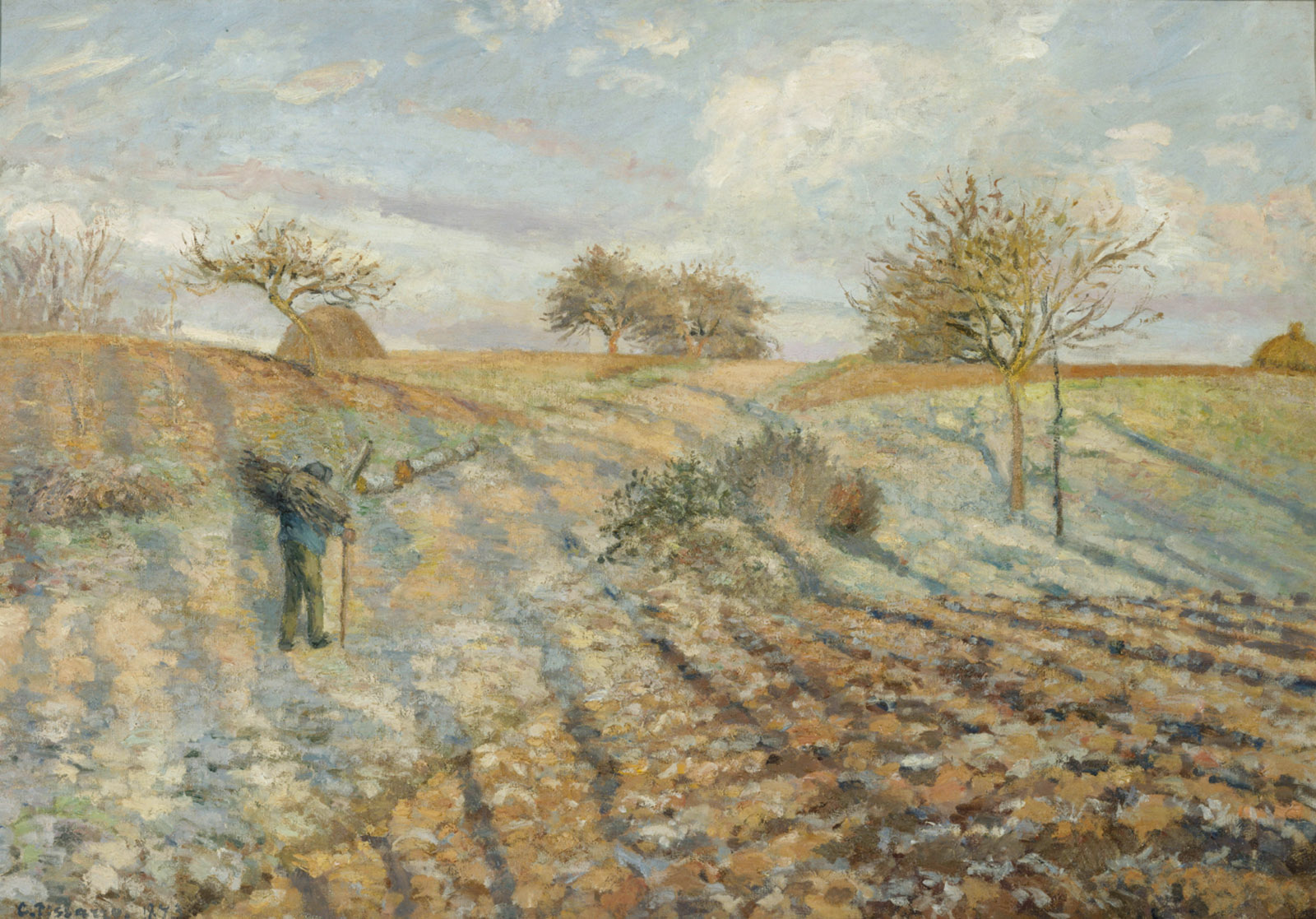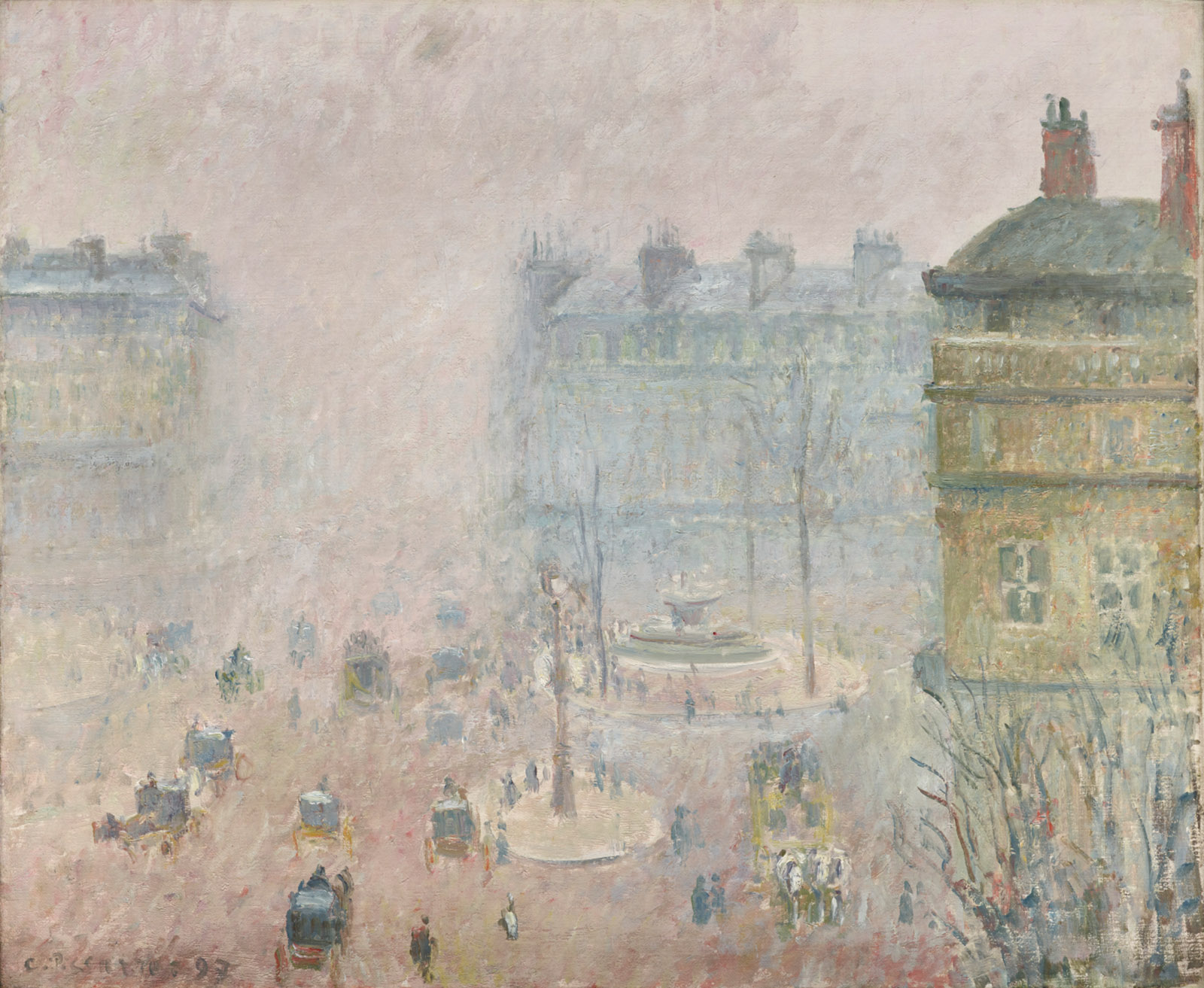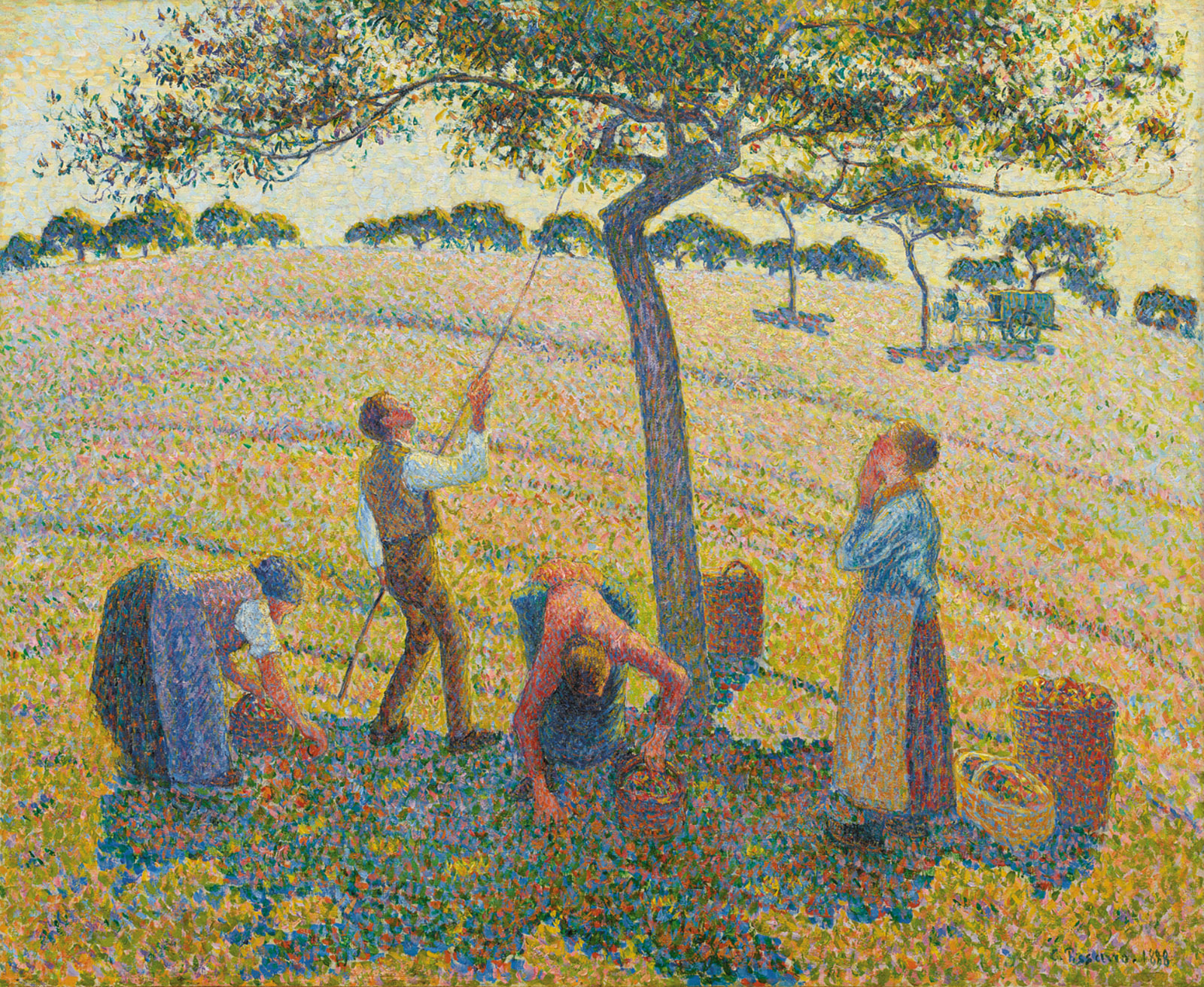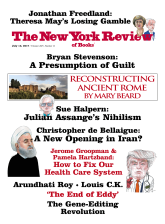What is a shadow? Nothing in itself, you might say: a mere local lack of light, in a space that is otherwise lit up. Light, which allows us to see and know the world, is the normal precondition for picturing things. Cast shadows may help us interpret a picture by indicating where light comes from and where objects stand, but if you survey art history, you find the majority of painters giving them minor parts at most. A minority, however, turns these assumptions upside down, treating shadow as the preexistent condition and light as its shock interruption. If Giotto, Bruegel, or Courbet present worlds to be seen and known, the seventeenth-century masters of chiaroscuro and their nineteenth-century sympathizers—think Manet’s Olympia—forsake solid fact in favor of dazzle. But once you open up that second possibility, a third emerges. Take shadow and light as opposite ends of a scale, and the tonal notes lying between them offer a means to compose pictorial music. The landscapes of Claude Lorrain or of Jean-Baptiste Corot show ways that such music might be played.
The art of Camille Pissarro—the subject of two current exhibitions in Paris, one at the Musée Marmottan Monet and the other at the Musée du Luxembourg—was rooted in this third tradition. Presenting his credentials to the Paris Salon in 1864, the thirty-three-year-old described himself as a pupil of Corot, even if his personal contact with that father figure to French landscape painters had been slight. Six years later Pissarro encountered other ways of doing landscape after he and his friend Claude Monet fled to London during the Franco-Prussian War. But when an English critic, shortly before Pissarro’s death in 1903, claimed that English art had radically enlarged their vision, the veteran painter, by now himself a father figure, indignantly reiterated that Claude Lorrain and Corot had been his mentors, and that
Turner and Constable, while they taught us something, showed us in their works that they had no understanding of the analysis of shadow, which in Turner’s painting is simply used as an effect, a mere absence of light.
What, then, might a shadow be, if it is not to remain a mere “effect” or an “absence”? A Pissarro canvas from 1873 that is now on view at the Marmottan suggests a possible answer. Oil painting can turn shadows from nothings into palpable somethings: slabs of rich color. The gently rising Île-de-France farmland depicted in Hoar Frost (Gelée blanche à Ennery) becomes an intricate weaving of russets, blue-greens, umbers, and pale yellows as morning sun shines on it from behind a row of poplars. As you approach the canvas, the bristles that have scuffed it with stiff, clotted brushloads seem to rasp your skin, and you are jolted into a poetry of chill January: a poetry sustained by close plein air observation and resolved with a scrupulous completeness.
At the same time, you may perhaps register the oddness of the operation. Those long stripes of shadow criss-crossing the ruts and country road are cast by no visible object. The colors of what’s sunlit and the colors of what isn’t meet in stout equivalence on the canvas, but for anyone on the scene—say that trudging peasant with his load of sticks—the former would have priority. We expect grass to be green more than we expect it to be blue. In effect, the shadows spook the comfortable farmland, nagging us with the consideration that a further unseen presence stands beneath the poplars, that of the observing artist.
That some critics of the day took against such oddities is a familiar feature of the story of Impressionism, the movement launched by the 1874 exhibition in which Pissarro paintings such as Hoar Frost appeared alongside work by Monet and others. Jules Castagnary, for instance, condemned the invisibility of those poplars as a “grave error,” whereas Louis Leroy sneered that the picture consisted of “palette-scrapings placed uniformly on a dirty canvas…neither head nor tail, top nor bottom, front nor back.”
Impressionism has itself become so nearly invisible through incessant exposure that it may be worth recovering some of that initial bemusement. The mudslinging Leroy was acknowledging that in this altered approach to painting, deep space—of the kind, say, that Claude Lorrain had made available—was no longer on offer. Nor did the new art respect the texture of objects. When Pissarro, elsewhere, depicts a pond, the oil paint refuses to lie down and be limpid and liquid: it cakes, it corrugates. Equally, his plowed earth is made without recourse to earth colors.
According to Cézanne, his closest associate at this time, it was Pissarro’s own decision to eliminate those pigments from his palette, along with the black that formed the base note of shadows. Let the scale revolve around the primaries, the positive constituents of optical experience; let the painting be a concrete analogue to events in the eye that affected the mind poetically. This was where Pissarro shifted away from Corot’s form of lyricism.
Advertisement
It was a levelheaded move, for all that it outraged Leroy. To visit the two Pissarro shows in Paris is to learn about levelheadedness. It is not that the outward world ceased to concern Pissarro, even if his art’s weighting shifted psychologically inward: to use his own terminology, “nature” and “sensation” were not opposed but interdependent. Nearly always, Pissarro composes poems about passing light that can be mapped intelligibly, letting you know just how this farmhouse lies behind that willow, how an orchard intervenes between it and a barn, or how some lane winds between the hedges and rivers and hillsides of verdant, bountiful northern France.
The slow-paced steadiness of this well-tended terrain and the slow-shifting tenacity of Pissarro’s interpretations of it are almost of a piece. Both speak of sustained and solid workmanship, testimony that feels fortifying. Pissarro landscapes are surely good for you. The exhibition at the Marmottan, which surveys his entire career, communicates overall a bracing sobriety of purpose. The paintings shown at the Musée du Luxembourg—where the focus is on Éragny, Pissarro’s rural base forty-eight miles northwest of Paris during his final two decades—take you to an upland of high achievement.
Besides temporary exhibitions, the Marmottan houses a permanent collection of Monets, and these prove an instructive contrast. Pissarro could never, unlike his Impressionist colleague, be accused of “excessive bravura of execution” or of “brilliant vulgarity.” (Those putdowns come from the aesthetically radical Félix Fénéon, criticizing Monet from the other side of the Impressionist revolution in 1888.) Pissarro preferred canvas sizes intended to appeal, in their modesty, to the private collector, rather than to bid for public glory: his brushwork, even when tortuously dense, always seeks for exactitude; and his selection of landscape motifs is fastidious, with a fondness for subtle, moisture-softened illumination. Not for him flash “effects” of shadow or light.
Yet the Marmottan show also points you back to the latent weirdnesses of that subject selection. It includes, for instance, a view of a hilltop concourse in the provincial town where Pissarro was living in 1872—Place du Vieux-Cimetière, Pontoise—in which the mansions disappearing down the far slope and a distant gathering of ladies in their Sunday best maintain an averted secrecy that excludes the painter, who stares at them across a large and vacant sunlit foreground. Alternately, in Gardeuse de vache (1883), a portrait-format painting done in tempera eleven years later, a bonneted cowherd and her cow loom giddily close to the body space of the observer, whose gaze strays down to the lush grass at his feet: they seem unconscious of him, however. How should I situate myself—so the painter’s underlying question runs—with regard to those others?
The creator of these distillations of provincial France was never a French citizen. The Pissarros were Jews who came from Portugal to Bordeaux, from which Camille’s father set sail for the Danish West Indies, there to trade as a haberdasher. Though the future artist was sent back to France for his schooling, many of his apprentice years were passed in the Caribbean, under the tutelage of Fritz Melbye, a slightly older Danish view painter.*
It was only at twenty-five that Pissarro settled in Paris. Upright, generous, independent-minded, and utterly devoted to his art, he gained the admiration of his colleagues there—to the nine-years-younger Cézanne, he was “rather like God”—so that while he may have lacked for buyers, he never lacked for friends. Moreover, with Julie Vellay, the Frenchwoman he married, he started to raise a large family. But whenever Pissarro—who always retained a Danish passport—stood at his easel to paint rural France, the question implicitly remained of his relation to this adopted terrain.
Characteristically, it led Pissarro toward a type of deliberate and generalizing reticence. Whereas there was specificity about the ways that light fell from hour to hour, season to season, upon the features of the French countryside—these being the incidents that inspired him lyrically—and while he could construe how those features hung together, he would not attempt to define whatever uses or histories those features might involve. There is little present or past to the views painted at Pontoise or Éragny.
If a factory chimney contributes to a sky’s flows of vapor, it is hardly inserted in a spirit of modern provocation, and really all that Pissarro expects to find is that here and there, paysannes, peasant women, will regularly be engaged in their peasant activities. He cares not much for just what those tasks consist of. What matters is the principle that there should be a pays, a land to which a class of figures belongs. It seems to be structured into Pissarro’s script that these earth-workers should be preponderantly female: indeed, the earliest work the Marmottan displays, Deux Femmes causant au bord de la mer (1856), a modest but luminous vista of a Caribbean bay, features two women porters. But Pissarro’s women are neither positively individualized nor significantly sexually charged. Not coincidentally, he had no particular facility when it came to figure drawing.
Advertisement
The first mid-career twist in the tale of this self-critical perennial student is that from his fifties onward, Pissarro felt a need to bring those peasant figures into the foreground. Witness that 1883 study of the cowherd. The move asks for explanation. Everyone in the France of those days had a prototype for compositions with peasant protagonists. It came from Jean-François Millet, painting at Barbizon, and it communicated the human condition at its starkest, with sweating bodies stuck between heaven and hard earth. Did Pissarro’s images of agricultural toil conform to this rhetoric, or did they alternately oppose themselves to it, being set in a so much gentler terrain?
It matters, you might argue, that Millet was a stoic, pessimistic conservative, whereas Pissarro—probably from his Caribbean youth onward—believed in the cause of revolution. He rejected religion and by 1884 had aligned himself with the then-vigorous anarchist movement. That was the year he settled at Éragny and started painting the pictures now featured at the Musée du Luxembourg. Richard Brettell and Joachim Pissarro, the two eminent Pissarro specialists curating this show, explore what connections might be made between the politics and the painting.
It seems, to an outside eye, rather an uphill exercise. Alongside the canvases they exhibit graphic work. In the roughs of Travaux des champs (Field work), a never-completed book project on which the painter worked with his artist son Lucien, blithe, bucolic figures appear, sowing, herding, feeding mechanical harvesters, and so on. As in the paintings, nothing seems to disrupt their idyll. Alternately, however, there are thirty sheets of Turpitudes Sociales, a sequence Pissarro inked in 1889 for circulation within his family. This was private because it was seditious: a caricatural tour of contemporary urban society in all its poverty, hypocrisy, and despair, the final image featuring a self-portrait as an old enragé who meets his end, pistol in hand, on the barricades of some sure-to-come uprising. Turpitudes may also have been private because although its sketches have heart, as exercises in the manner of Daumier they are painfully tentative.
The two sides of the silver-bearded patriarch that Pissarro had become, the calm-tempered blesser of the rural round and the trigger-happy blaster of the bourgeoisie, don’t unite to deliver a cohesive pictorial politics. The curators hunt for deeper structural affinities. In the catalog accompanying the Luxembourg exhibition, Brettell suggests that Pissarro’s classical interpretations of the countryside relate on some level to the thinking of the anarchist geographer Élisée Reclus. Joachim Pissarro (the great-grandson of the painter) roundly acknowledges that the painter “did not employ his brush and colors for ideological ends, any more than he chose his political positions to serve his interests as an artist.” He argues, however, that anarchism entailed autonomy, namely the principle that each person should embark on an individual reckoning of his stock of lived experience, and that such an ethos can be seen to inform Camille in his aesthetics of “sensation.”
The paradox (and this is where anarchism conformed to an age-old religious logic) was that to arrive at a sound understanding of your own texture of existence—and hence of your essence as an artist—you might need to submit to what others could show you. In his mid-fifties, having based himself at Éragny, Pissarro fell in with young Paris charismatics: Paul Signac, Fénéon, above all Georges Seurat. It was clear to him, he wrote in 1886, that these twenty-somethings had arrived at “a modern synthesis through scientifically established methods” that would at the same time advance the causes of “originality” and of “individual vision.” The artistic insurgency that he and Monet had launched must now, he advocated—in the face of his colleagues’ skepticism—move onward and upward.
Fired by convert zeal, Pissarro started butting his canvases with tiny hog-brush flecks of hues meant to jangle and interpenetrate, and thus to restage the retina’s primal encounters with light, the very moments when “nature” turned into “sensation.” And undeniably, the method delivered. In paintings such as the 1888 Apple Harvest, on view at the Luxembourg, Pissarro speaks to the eyes as if he had suddenly been equipped with a megaphone. The super-resonance combines here with studiously balanced intervals and a panoramic horizon to create a poem of arcadian exultation. One that remains, as usual, temperate: the canvas is only twenty-eight inches wide.
And yet the picture is not exactly a declaration of freedom. What is a shadow? How does the impacted, blue-fringed body of paint beneath the apple tree relate to that phenomenon in nature? Abolishing a natural shadow’s evanescence, the exacting chromatic analysis threatens to trap us in artifice. That may have been an outcome that Seurat was happy to settle for, argues Christophe Duvivier, one of the Marmottan’s curators, but unlike the guru of “Neo-Impressionism,” Pissarro was not abstractionist by instinct. What his art throve on, rather, was “a sensorial present,” “a moment in life.” As a result he soon began searching for a more porous way to handle paint, one quicker to respond to outward stimulus while retaining the insights gained from optical science. The Luxembourg show demonstrates the high rewards these investigations delivered. The country views that Pissarro painted at Éragny during his sixties seem the most richly layered and the most deeply felt of his whole career.
Deeply felt, and yet still in some senses reticent and remote. Partly this is a matter of personality. It is not hard to connect the tenderness devoted to sunset meadows and winter hedgerows to the shy self-portraitist who hides behind a bushy white beard and who, when attempting that classic French pictorial trope, the bather in a woodland stream, finds his mettle deserts him: the result (Woman Bathing Her Feet in a Brook, 1895) is feebly pretty, almost insincere. Partly, at the same time, it’s an issue of practicality. The aging painter had eye trouble, which made it hard for him to work outdoors, especially when the wind was up. A purpose-built studio at Éragny—although his finances were ever precarious, he was by now in a position to afford one—gave him a safely distanced vantage point for many of the overviews painted during these final years. But the need to steer clear of the weather also prompted one further surprising late sidestep.
At the age of sixty-three, Pissarro started turning his attention to the city. Over his remaining ten years, he completed hundreds of urban views in campaigns of work conducted in Paris and the Normandy ports. Back at the Marmottan, we see views of the façades of the Haussmannian metropolis in all their smug blond limestone and purple slate; gaslit boulevards with lines of idling fiacres; pedestrians swarming across sunlit Seine bridges; chimneys puffing, engines puffing, downriver at Rouen; tiny quayside figures, watching the boats that sail in or depart for the never-quite-to-be-revealed open horizon.
What is the quality that these captivating exercises, with all their subtle silverinesses and their variegation of touch, intend to close in on? Is it the “modernity” about which Pissarro’s rural imagery remained so strikingly agnostic? No doubt it is: but in a rather specialized sense, I feel. These are pictures of the texture of experience that is peculiar to looking at the outside world through a fourth-floor hotel window. Sensation, it emerges, has here become a sheet of glass.
-
*
This relationship is explored in “Pissarro: A Meeting on St. Thomas,” an exhibition, based on recent research, at the Ordrupgaaard Museum, Charlottenlund, Denmark (March 10–July 2, 2017). The tale of the two young artists’ travels is fascinating, and the images of Caribbean scenery and street life that they drew and painted are evocative and often of marvelous quality. Indirectly, Melbye’s influence on Pissarro complemented Corot’s, for behind the Danish Golden Age manner in which Melbye had been trained lay a tonal approach to “landscape portraiture” that had been developed by artists working in early-nineteenth-century Rome, and Corot was likewise their beneficiary. The great American landscapist Frederic Edwin Church (1826–1900) also enters the story, since Melbye later became his friend and a large body of Melbye’s and Pissarro’s youthful studies came into his keeping. As of this writing, the catalog was only available in Danish. ↩






